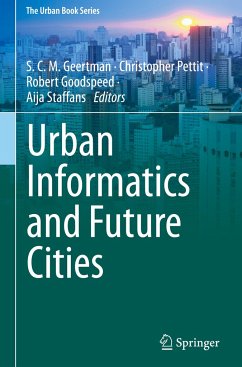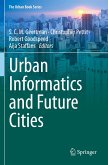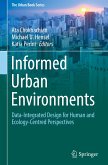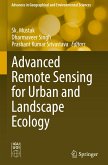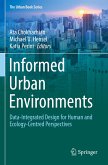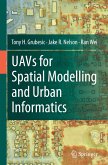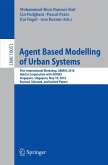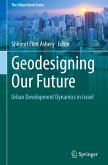Urban Informatics and Future Cities
Herausgegeben:Geertman, S. C. M.; Pettit, Christopher; Goodspeed, Robert; Staffans, Aija
Urban Informatics and Future Cities
Herausgegeben:Geertman, S. C. M.; Pettit, Christopher; Goodspeed, Robert; Staffans, Aija
- Gebundenes Buch
- Merkliste
- Auf die Merkliste
- Bewerten Bewerten
- Teilen
- Produkt teilen
- Produkterinnerung
- Produkterinnerung
This book forms a selection of chapters submitted for the CUPUM (Computational Urban Planning and Urban Management) conference, held in the second week of June 2021 at Aalto University in Helsinki, Finland. Chapters were selected from a double-blind review process by the conference's scientific committee. The chapters in the book cover developments and applications with big data and urban analytics, collaborative urban planning, applications of geodesign and innovations, and planning support science.
Andere Kunden interessierten sich auch für
![Urban Informatics and Future Cities Urban Informatics and Future Cities]() Urban Informatics and Future Cities168,99 €
Urban Informatics and Future Cities168,99 €![Informed Urban Environments Informed Urban Environments]() Informed Urban Environments100,99 €
Informed Urban Environments100,99 €![Advanced Remote Sensing for Urban and Landscape Ecology Advanced Remote Sensing for Urban and Landscape Ecology]() Advanced Remote Sensing for Urban and Landscape Ecology164,99 €
Advanced Remote Sensing for Urban and Landscape Ecology164,99 €![Informed Urban Environments Informed Urban Environments]() Informed Urban Environments100,99 €
Informed Urban Environments100,99 €![UAVs for Spatial Modelling and Urban Informatics UAVs for Spatial Modelling and Urban Informatics]() Tony H. GrubesicUAVs for Spatial Modelling and Urban Informatics119,99 €
Tony H. GrubesicUAVs for Spatial Modelling and Urban Informatics119,99 €![Agent Based Modelling of Urban Systems Agent Based Modelling of Urban Systems]() Agent Based Modelling of Urban Systems38,99 €
Agent Based Modelling of Urban Systems38,99 €![Geodesigning Our Future Geodesigning Our Future]() Geodesigning Our Future115,99 €
Geodesigning Our Future115,99 €-
-
-
This book forms a selection of chapters submitted for the CUPUM (Computational Urban Planning and Urban Management) conference, held in the second week of June 2021 at Aalto University in Helsinki, Finland. Chapters were selected from a double-blind review process by the conference's scientific committee. The chapters in the book cover developments and applications with big data and urban analytics, collaborative urban planning, applications of geodesign and innovations, and planning support science.
Produktdetails
- Produktdetails
- The Urban Book Series
- Verlag: Springer / Springer International Publishing / Springer, Berlin
- Artikelnr. des Verlages: 978-3-030-76058-8
- 1st edition 2021
- Seitenzahl: 644
- Erscheinungstermin: 16. Juli 2021
- Englisch
- Abmessung: 241mm x 160mm x 31mm
- Gewicht: 1237g
- ISBN-13: 9783030760588
- ISBN-10: 3030760588
- Artikelnr.: 61427493
- Herstellerkennzeichnung Die Herstellerinformationen sind derzeit nicht verfügbar.
- The Urban Book Series
- Verlag: Springer / Springer International Publishing / Springer, Berlin
- Artikelnr. des Verlages: 978-3-030-76058-8
- 1st edition 2021
- Seitenzahl: 644
- Erscheinungstermin: 16. Juli 2021
- Englisch
- Abmessung: 241mm x 160mm x 31mm
- Gewicht: 1237g
- ISBN-13: 9783030760588
- ISBN-10: 3030760588
- Artikelnr.: 61427493
- Herstellerkennzeichnung Die Herstellerinformationen sind derzeit nicht verfügbar.
Prof. S. C. M. Geertman is full Professor in Planning Support Science and Chair of Spatial Planning at Utrecht University in the Netherlands. He has published widely in (inter-)national journals and has edited a range of scientific books in the field of Planning Support Science. He is/was (co-)editor of several international peer-reviewed journals (e.g., ASAP - Applied Spatial Analysis and Policy) and serves on the editorial boards of diverse scientific journals (e.g. CEUS - Computers, Environment, and Urban Systems). He has been chair/member of several international conference organizations (EGIS; JECC; AGILE-2011; DDSS; CUPUM-2013) and was for the past 10 years Chair of the International Board of Directors of CUPUM (Computational Urban Planning and Urban Management). He has participated in numerous interdisciplinary research projects, ranging from 'Climate change and sustainable land use' to 'Spatial economic deconcentration'. For 10 years he was the scientific director of an academic spin-off of Utrecht University (Nexpri) and was one of the founding fathers and first program director of the inter-university Master program GIMA (Geographical Information Management and Applications). His research interest can be categorized under the heading 'Planning Support Science for Sustainable Urban Futures'. Chris Pettit is the Director of the City Futures Research Centre, inaugural professor of Urban Science, and Plus Alliance Fellow at UNSW Sydney. He currently Chair of the Board of Directors for CUPUM (Computational Urban Planning and Urban Management). He is a member of the Planning Institute of Australia's National Plantech Working Group, the advisory board for the Centre for Data Leadership, the Committee for Sydney's Smart Cities Taskforce and the NSW Government Expert Advisory Group for Planning Evidence and Insights. Prof. Pettit established the City Analytics Lab (CAL), a dedicated space designed to support collaborative city planning and user-centred design. He Chief investigator on a number of ARC, CRC and Industry projects including: The Rapid Analytics Interactive Scenario Explorer (RAISE) Toolkit which has been the recepient of the NSW Planning Institute of Australia's Award for Research Excellence and the Committee for Sydney's award for Smart Cities - Industry partnership. Prof. Pettit's expertise is in the convergence of the fields of city planning and digital technologies including Geographical Information Systems (GIS) and Planning Support Systems (PSS). He has given numerous keynote addresses at conferences around the world, is on the editorial board for a number of journals and has published over 200 academic papers. For the last 25 years, he has been undertaking research and development in the use of digital tools to support evidenced-based spatial planning. Robert Goodspeed is an assistant professor of urban and regional planning at the University of Michigan's Taubman College of Architecture and Urban Planning. He teaches and conducts research in the areas of collaborative planning, planning support systems, urban informatics, and scenario planning theory and methods, and is the author of the book Scenario Planning for Cities and Regions: Managing and Envisioning Uncertain Futures. He is a member of the American Institute of Certified Planners, and serves on the boards of the conference Computational Urban Planning and Urban Management (CUPUM) and the Consortium for Scenario Planning, an initiative of the Lincoln Institute of Land Policy. Dr. Aija Staffans is an architect and works as Senior Research Fellow at Aalto University, Finland. Staffans is a pioneer in developing participative methods, digitally supported platforms and interactive environments for urban development and collaborative land use proces¬ses. She has initiated and leads the Aalto Built Environment Lab ABE for investigating innovative planning and design methodology. She also leads the multi-disciplinary research network of human-centered living environments, Living+, at Aalto since 2018. She holds several positions of trust and expertise in academic, professional and NGO organizations, and has impacted the development of urban planning in practice at various levels from local guidelines to national legislation in Finland.
Introduction.- Part I: Data analytics and the COVID-19 pandemic.- Smart governance and COVID-19 control in Wuhan, China.- Using public-private data to understand compliance with mobility restrictions in Sierra Leone.- Development of a spatio-temporal analysis method to support the prevention of COVID-19 infection: Space-time Kernel density estimation using GPS location history data.- Part II: Big data and smart cities.- A review of spatial network insights and methods in the context of planning: Applications, challenges, and opportunities.- Transport infrastructure, Twitter and the politics of public participation.- Public perceptions and attitudes towards driverless technologies in the United States: A text mining of Twitter data.- Assessing the value of new big data sources for transportation planning: Benton Harbor, Michigan case study.- How various natural disasters impact urban human mobility patterns: A comparative analysis based on geotagged photos taken in Tokyo.- Revealing the spatial preferences embedded in online activities: A case study of Chengdu, China.- Part III: Data-driven research of activity patterns.- Application for locational intelligence and geospatial navigation (ALIGN): Smart navigation tool for generating routes that meet individual preferences.- Pedestrian behaviour characteristics based on an activity monitoring survey in a university campus square.- Developing a GIS-based tourist walkability index based on the AURIN walkability toolkit - Case study: Sydney CBD.- Sequential patterns of daily human activity extracted from person trip survey data.- Understanding the economic value of walkable cities.- (Big) data in urban design practice: Supporting high-level design tasks using a visualization of human movement data from smartphones.- Examining passenger vehicle miles traveled and carbon emissions in the Boston metropolitan area.- Part IV: Open data and spatial modeling.- Development of a household urban micro-simulation model (HUMS)using available open-data and urban policy evaluation.- An agent-based bushfire visualisation to support urban planning: A case study of the South Coast, NSW 2019-2020.- Development of an agent-based model on the decision-making of dislocated people after disasters.- Evidence-based design justice: Synthesizing statistics and stories - to create future "Just" cities.- Part V: Geodesign and planning support systems (PSS).- Geodesign between IGC and geodesignhub: Theory and practice.- The role of technology tools to support geodesign in resilience planning.- Planning support systems for long-term climate resilience: A critical review.- Part VI: Geospatial data analysis.- Aggregation of geospatial data on "street units": The smallest geographical unit of urban places.- Local betweenness centrality analysis of 30 European cities.- Model for estimation of building structure and built year using building façade images and attributes obtained from a real estate database.- A spatial analysis ofcrime incidence and security perception around a university campus.- Sightseeing support system with augmented reality and no language barriers.- GeoMinasCraft: A serious geogame for geographical visualization and exploration.
Introduction.- Part I: Data analytics and the COVID-19 pandemic.- Smart governance and COVID-19 control in Wuhan, China.- Using public-private data to understand compliance with mobility restrictions in Sierra Leone.- Development of a spatio-temporal analysis method to support the prevention of COVID-19 infection: Space-time Kernel density estimation using GPS location history data.- Part II: Big data and smart cities.- A review of spatial network insights and methods in the context of planning: Applications, challenges, and opportunities.- Transport infrastructure, Twitter and the politics of public participation.- Public perceptions and attitudes towards driverless technologies in the United States: A text mining of Twitter data.- Assessing the value of new big data sources for transportation planning: Benton Harbor, Michigan case study.- How various natural disasters impact urban human mobility patterns: A comparative analysis based on geotagged photos taken in Tokyo.- Revealing the spatial preferences embedded in online activities: A case study of Chengdu, China.- Part III: Data-driven research of activity patterns.- Application for locational intelligence and geospatial navigation (ALIGN): Smart navigation tool for generating routes that meet individual preferences.- Pedestrian behaviour characteristics based on an activity monitoring survey in a university campus square.- Developing a GIS-based tourist walkability index based on the AURIN walkability toolkit - Case study: Sydney CBD.- Sequential patterns of daily human activity extracted from person trip survey data.- Understanding the economic value of walkable cities.- (Big) data in urban design practice: Supporting high-level design tasks using a visualization of human movement data from smartphones.- Examining passenger vehicle miles traveled and carbon emissions in the Boston metropolitan area.- Part IV: Open data and spatial modeling.- Development of a household urban micro-simulation model (HUMS)using available open-data and urban policy evaluation.- An agent-based bushfire visualisation to support urban planning: A case study of the South Coast, NSW 2019-2020.- Development of an agent-based model on the decision-making of dislocated people after disasters.- Evidence-based design justice: Synthesizing statistics and stories - to create future "Just" cities.- Part V: Geodesign and planning support systems (PSS).- Geodesign between IGC and geodesignhub: Theory and practice.- The role of technology tools to support geodesign in resilience planning.- Planning support systems for long-term climate resilience: A critical review.- Part VI: Geospatial data analysis.- Aggregation of geospatial data on "street units": The smallest geographical unit of urban places.- Local betweenness centrality analysis of 30 European cities.- Model for estimation of building structure and built year using building façade images and attributes obtained from a real estate database.- A spatial analysis ofcrime incidence and security perception around a university campus.- Sightseeing support system with augmented reality and no language barriers.- GeoMinasCraft: A serious geogame for geographical visualization and exploration.

